copyright © 2009 Douglas Tong, all
rights reserved
The following article is the second part of an interview with Såzen Larsen Kusano Sensei of the Sugino branch of Katori Shinto Ryu. In this article, Såzen Sensei talks to us about the Katori Shinto Ryu school of Japanese swordsmanship. Those interested in learning more about Såzen Sensei can consult his group’s website: http://www.kakudokan.no/
Author’s note: This interview was conducted on August 7, 2009 in St. Catharines, Ontario, Canada. Såzen (pronounced “Sozen”) Sensei came over to Canada to conduct another special seminar in Katori Shinto Ryu. This was his third trip to Canada.
Question: What is Katori Shinto Ryu?
Sensei: In my humble opinion, truly I do not know because it’s a big question. But I know some things and I know it’s old school kendo, old school swordsmanship.
But it’s not only about sword. There’s jujutsu, naginata, bo, spear, and other things. That makes it different from some other schools.

Tachi Zue no kamae waiting stance
(bo jutsu, Katori Shinto Ryu)
So what is it on a technical level?
A lot of techniques!! (Sensei laughs.)
Question: Why was the style named Katori Shinto Ryu?
Sensei: Katori is the name of a place in Japan. This style was founded inside the premises of a very famous Shinto shrine called Katori Dai-Jingu.
The official name of the style includes the words “Tenshin Shoden” because it was transmitted from the deities in heaven.
Ten – Heaven
Shin – Correct
Sho – True
Den – Conveyed or Transmitted
Question: Katori Shinto Ryu is very famous. Why do you think this is?
Sensei: I’m not so sure it is that famous. In Sugino Dojo, it is. In some circles, it is. A lot of people hold it in high esteem. But I really don’t know how famous it is.
Karate, aikido, judo, kendo. These are famous.
Question: You have seen and practiced other sword styles. In your opinion, what makes Katori Shinto Ryu unique among sword styles? How is it different from other sword styles?
Sensei: Of course, they are all unique, that’s for sure. What makes Shinto Ryu stick out a little bit, in my opinion, is that they have kept the tradition intact. In terms of other aspects, there are various weapons and there are jujutsu techniques as well. And the forms are quite long.

Kusanagi (“grass cutting”) attacking technique
(naginata jutsu, Katori Shinto Ryu)
Question: You mentioned other weapons. Katori Shinto Ryu is a system that includes many different kinds of weapons. Why is this?
Sensei: Using a modern analogy, let’s consider a modern soldier. As a soldier, you need to learn to use a wide range of different weapons. Guns, rifles, pistols, bazooka. Small weapons, big weapons, long weapons, short weapons. You’d need to know them all or at least be familiar with them.
If you belong to a certain group of professionals, like tradesmen, you need to be able to handle a toolbox. With regards to swordsmen, to this particular group of professionals, the toolbox does not include tonfa, sai, and nunchaku. Likewise, a dentist will not use a wrench.
Question: So, do you mean that this is part of our “professional responsibility”?
Sensei: Yes, you need to be able to handle an arsenal. As a samurai, you can’t say, “Oh, a spear??” You also can’t say, “Sorry, I’m not familiar with that tool…”

Belly-stabbing technique (so jutsu [spear], Katori Shinto Ryu)
I have a friend and student who works for the Royal Family in Norway. He is part of the Secret Service detail guarding the Royal Family. He must be familiar with and adept at using a variety of weapons, everything from brass knuckles and sticks to guns to blades. It really is part of his professional responsibility.
Question: You have also studied iaido. What style did you study?
Sensei: I studied Muso Jikiden Eishin Ryu Otha-ha under Soke Hiromasa Serizawa in Tokyo. I studied with my teacher for many, many years.

Såzen Sensei learning Muso Jikiden Eishin Ryu iaido with Serizawa Sensei
Question: Katori Shinto Ryu also has an iaijutsu component in their curriculum. Is it different from iaido? If so, can you tell us how it is different from iaido?
Sensei: If we think back to defining jutsu and do, in the big picture, it’s no different. The elements of Shinto Ryu iai, which means “meeting with an opponent”, are the same as in the iaido schools. The basic premise is also the same, which essentially is to “observe – draw – cut – return.”

Såzen Sensei being instructed in Katori Shinto Ryu iaijutsu by Yoshio Sugino Sensei
The difference is like apples and oranges. But we eat them both. They’re both good for us. And what do we call them?
Fruits!! (Sensei laughs.)
For more information about Katori Shinto Ryu, visit: Katori Shinto Ryu.
Mr. Tong can be contacted via email at: dtong@tokumeikan.com
The following article is the second part of an interview with Såzen Larsen Kusano Sensei of the Sugino branch of Katori Shinto Ryu. In this article, Såzen Sensei talks to us about the Katori Shinto Ryu school of Japanese swordsmanship. Those interested in learning more about Såzen Sensei can consult his group’s website: http://www.kakudokan.no/
Author’s note: This interview was conducted on August 7, 2009 in St. Catharines, Ontario, Canada. Såzen (pronounced “Sozen”) Sensei came over to Canada to conduct another special seminar in Katori Shinto Ryu. This was his third trip to Canada.
Question: What is Katori Shinto Ryu?
Sensei: In my humble opinion, truly I do not know because it’s a big question. But I know some things and I know it’s old school kendo, old school swordsmanship.
But it’s not only about sword. There’s jujutsu, naginata, bo, spear, and other things. That makes it different from some other schools.
Tachi Zue no kamae waiting stance
(bo jutsu, Katori Shinto Ryu)
So what is it on a technical level?
A lot of techniques!! (Sensei laughs.)
Question: Why was the style named Katori Shinto Ryu?
Sensei: Katori is the name of a place in Japan. This style was founded inside the premises of a very famous Shinto shrine called Katori Dai-Jingu.
The official name of the style includes the words “Tenshin Shoden” because it was transmitted from the deities in heaven.
Ten – Heaven
Shin – Correct
Sho – True
Den – Conveyed or Transmitted
Question: Katori Shinto Ryu is very famous. Why do you think this is?
Sensei: I’m not so sure it is that famous. In Sugino Dojo, it is. In some circles, it is. A lot of people hold it in high esteem. But I really don’t know how famous it is.
Karate, aikido, judo, kendo. These are famous.
Question: You have seen and practiced other sword styles. In your opinion, what makes Katori Shinto Ryu unique among sword styles? How is it different from other sword styles?
Sensei: Of course, they are all unique, that’s for sure. What makes Shinto Ryu stick out a little bit, in my opinion, is that they have kept the tradition intact. In terms of other aspects, there are various weapons and there are jujutsu techniques as well. And the forms are quite long.
Kusanagi (“grass cutting”) attacking technique
(naginata jutsu, Katori Shinto Ryu)
Question: You mentioned other weapons. Katori Shinto Ryu is a system that includes many different kinds of weapons. Why is this?
Sensei: Using a modern analogy, let’s consider a modern soldier. As a soldier, you need to learn to use a wide range of different weapons. Guns, rifles, pistols, bazooka. Small weapons, big weapons, long weapons, short weapons. You’d need to know them all or at least be familiar with them.
If you belong to a certain group of professionals, like tradesmen, you need to be able to handle a toolbox. With regards to swordsmen, to this particular group of professionals, the toolbox does not include tonfa, sai, and nunchaku. Likewise, a dentist will not use a wrench.
Question: So, do you mean that this is part of our “professional responsibility”?
Sensei: Yes, you need to be able to handle an arsenal. As a samurai, you can’t say, “Oh, a spear??” You also can’t say, “Sorry, I’m not familiar with that tool…”
Belly-stabbing technique (so jutsu [spear], Katori Shinto Ryu)
I have a friend and student who works for the Royal Family in Norway. He is part of the Secret Service detail guarding the Royal Family. He must be familiar with and adept at using a variety of weapons, everything from brass knuckles and sticks to guns to blades. It really is part of his professional responsibility.
Question: You have also studied iaido. What style did you study?
Sensei: I studied Muso Jikiden Eishin Ryu Otha-ha under Soke Hiromasa Serizawa in Tokyo. I studied with my teacher for many, many years.
Såzen Sensei learning Muso Jikiden Eishin Ryu iaido with Serizawa Sensei
Question: Katori Shinto Ryu also has an iaijutsu component in their curriculum. Is it different from iaido? If so, can you tell us how it is different from iaido?
Sensei: If we think back to defining jutsu and do, in the big picture, it’s no different. The elements of Shinto Ryu iai, which means “meeting with an opponent”, are the same as in the iaido schools. The basic premise is also the same, which essentially is to “observe – draw – cut – return.”
Såzen Sensei being instructed in Katori Shinto Ryu iaijutsu by Yoshio Sugino Sensei
The difference is like apples and oranges. But we eat them both. They’re both good for us. And what do we call them?
Fruits!! (Sensei laughs.)
For more information about Katori Shinto Ryu, visit: Katori Shinto Ryu.
Mr. Tong can be contacted via email at: dtong@tokumeikan.com